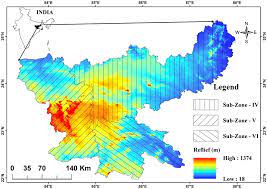Jharkhand is located in eastern India. The climate of Jharkhand is influenced by its geographical location, topography, and proximity to the Bay of Bengal. The state’s climate can be broadly categorized as a subtropical climate with distinct seasonal variations.

Subtropical Climate
-
- Jharkhand falls under the subtropical climate zone due to its location in the central part of India, away from the moderating influence of the seas.
- The state experiences pronounced seasonal changes, with distinct summers, monsoons, and winters.
Summer (March to June)
-
- Summers in Jharkhand are hot and dry, with temperatures ranging from 35°C to 45°C (95°F to 113°F) in the lowland areas.
- The highland regions, like the Chotanagpur Plateau, may have slightly lower temperatures during this season.
- The hot and dry conditions during summers are typical of the interior parts of India.
Monsoon (June to September)
-
- The southwest monsoon brings significant rainfall to Jharkhand during the months of June to September.
- The state receives a considerable amount of precipitation during this season, which is vital for its agriculture and water resources.
- The monsoon rains rejuvenate the landscapes, replenish water bodies, and support the growth of crops.
Post-Monsoon (October to November)
-
- After the monsoon season, Jharkhand experiences a transition period known as the post-monsoon season.
- During this time, the rainfall gradually decreases, and the weather becomes more pleasant.
Winter (December to February)
-
- Winters in Jharkhand are cool and relatively dry, with temperatures ranging from 10°C to 20°C (50°F to 68°F) in the lowland areas.
- The highland regions can experience cooler temperatures, with the nights sometimes getting quite cold.
- Foggy conditions may occur in some areas, especially in the early mornings, leading to reduced visibility.
The climate of Jharkhand is also influenced by its topography, which consists of plateaus, hills, and valleys. The Chotanagpur Plateau and the Santhal Parganas region experience a more temperate climate compared to the lower plains.
Overall, Jharkhand’s subtropical climate with hot summers, a significant monsoon season, and cool winters has a direct impact on its agriculture, economy, and way of life for its residents. The state’s natural beauty, combined with its diverse climate, adds to its charm and makes it an interesting subject of study for geographers and researchers.
Important Links